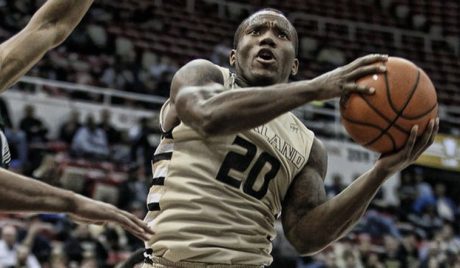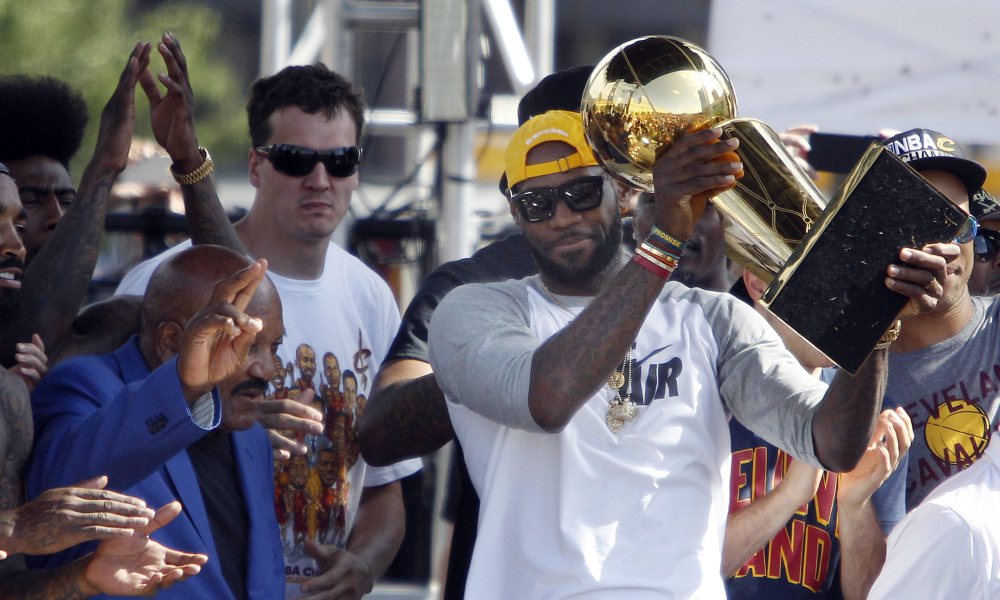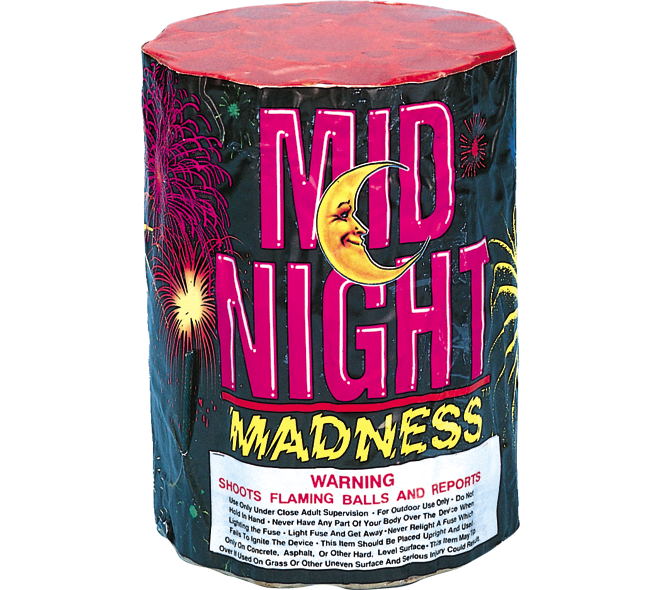
The Point Four-ward: The Point’s the Point
2016-06-29
Four points I’m thinking about the Cleveland Cavaliers…
1.) The champagne bubbles have fizzled out, all the confetti has been swept up, and J.R. Smith has finally resumed wearing a shirt… well, presumedly. While Cavs fans continue to bask in the championship afterglow, though, it’s time for the Cavs front office to get back to work.
David Griffin has already defined his basic strategy for the off-season. In an interview with ESPN Radio, Griffin said, quite simply, “We… intend to keep this group together and see what we’re capable of.” After off-seasons past, where the drama surrounding the Cavs was enough to win a Tony Award (for Best Play, of course… for as good of a roller coaster as the Cavs have been the last couple years, they’re not beating Hamilton), hearing these words from the Cavs General Manager had to be good news for fans and players alike.
Of course, it’s easy to say that you intend to keep this group together… and damn near impossible to do. Even if the Cavs re-sign Smith and Richard Jefferson and the bulk of the championship rotation returns, there will be some changes. Even though Channing Frye saw little time in the Finals, he was a key contributor throughout the Eastern Conference leg of the playoffs and solidified his place as the team’s third big man. That means Timofey Mozgov is unlikely to return. Dahntay Jones ended up being a fantastic last-day-of-the-season pickup by the Cavs, but the Cavs will likely try to use any minutes he’d receive to develop Jordan McRae, whose team option for just under $1 million the Cavs picked up yesterday.
2.) When discussing which of the Cavs key free agents is most likely to move on, one name keeps coming up: back-up point guard Matthew Dellavedova.
Last year, the Cavs opted to save a little on their luxury tax hit by giving Delly a modest raise (to $1.34 million) but also allowing him to become a restricted free agent this year. Dellavedova capitalized by having a stellar regular season, in which he, as a back-up, outplayed many teams’ starting point guards.
For the Cavs, though, it’s not like Dellavedova will be unseating Kyrie Irving for starting duties anytime soon. Being able to bring Delly off the bench was a huge luxury for this team. As Griffin and team owner Dan Gilbert look at a payroll that will once again be well over the luxury tax limit, there’s the very real possibility that some team offers Delly a deal that would make that luxury too expensive for even Gilbert to rationalize.
What is Dellavedova’s worth on the open market? ESPN.com’s Jeremias Engelmann put it in perspective. He wrote:
[D]uring the regular season, the Cavs played better with Dellavedova on the court than they did with Irving. The difference wasn’t small, either. Once we adjust for strength of teammates, Dellavedova’s units were about 10 points better per 100 possessions.
The Cavs’ offense didn’t miss a beat with Dellavedova, and they defended significantly better. The reason? Irving often forgets defensive assignments and shows an overall disinterest in playing defense, while Dellavedova haunts his opponents over the entire length of the court. Although Dellavedova doesn’t have Irving’s elite handle, he records more assists. He’s also a capable 3-point shooter and connected on more than 40 percent of his attempts. Thanks to a low turnover rate, Dellavedova sports a superior assist-to-turnover ratio (almost 3).
Obviously, Irving is the more talented overall player — and among the NBA’s elite when he’s sufficiently motivated and locked in. He’s the one you’d want in crunch time against good defensive teams when shot creation is difficult. In almost any other situation, however, we’d go with Dellavedova, especially once you look at their respective salaries.
Last summer, Dellavedova signed a $1.2 million contract for a single season. Given his stellar plus-minus numbers, there should be no doubt that he is worth that many times over.
3.) Which brings us to the player Gilbert just paid $2.4 million for the right to draft in the second round. Any projection of Kay Felder‘s future with the team should be taken with a healthy dose of doubt. But, just a few hours after writing this…
Fringe benefit of your team being #NBAChamps… not having to talk yourself into the rotational relevance of a pick in the late-20s. #Cavs
— Robert Attenweiler (@Cadavalier) June 23, 2016
… I was now talking myself into the rotational relevance of the 54th overall pick… who just happens to be 5-9.
But, hey, talking yourself into things is what the off-season is all about, so here we go:
ESPN’s Brian Windhorst characterized the drafting of Felder as a “total Dan Gilbert move” on his “Hey, Windy” podcast this weekend. He meant that Felder played for Oakland University — which is located in Rochester, Michigan, right outside of Detroit — so, the Cavaliers owner, a Detroit resident himself, was well aware of Felder and may have fallen in love with this exciting, play-making guard, who averaged 24.4 points and 9.3 assists per game this past season.
It has also been reported that Cavs scout Brandon Weems, who was an assistant coach at Oakland, and maybe even James himself were big proponents of drafting Felder. So, it seems like Felder has his share of fans within the organization, which never hurts.
But, even if Mo Williams is healthy enough to back-up Irving this year, does Felder have what it takes to make this team and contribute?
DraftExpress does a great job of breaking down Felder’s strengths and weaknesses. When discussing his strengths, you’ll notice that they compare moves that Felder makes now to moves that Celtics guard Isaiah Thomas — 5-9 like Felder — has had success with in the pros.
Both Thomas and Nate Robinson (another Felder comp, based on Felder’s outstanding athleticism) found success in the league early on in their careers and that makes some sense. These guys have been training to succeed against taller, longer competition all their lives. It takes a special sub-6-foot guard to make a mark in this league the way Thomas has, though, and Felder has yet to face any real NBA competition.
4.) Among the weaknesses DraftExpress listed, the one that stood out most glaringly was Felder’s lack of length. He seemed invisible on the court at times, with taller players passing and shooting over Felder with ease.
That may seem like an obvious problem given his height, but all 5-9 players are not created equal. While some of Felder’s measureables are encouraging (his 44″ max vertical, for instance), his standing vertical of 7-4.5 feet is a full four inches shorter than Thomas’s. While his wingspan is actually an inch better than Thomas’s, his ability to take up enough space to be disruptive on the defensive end will continue to be a question. In fact, when looking at the NBA’s best players under 6-feet, Felder could stack up more in line with the likes Shane Larkin and J.J. Barea, both shorter guards without the length to make up for their height (and, maybe even then, only if the Cavs are lucky).
Felder’s college coach admitted that they often hid Felder on defense because of the offensive load they expected him to carry. Since then, Felder has worked hard to dispel the notion that he can’t play D. In fact, DraftExpress’s Jonathan Givony wrote this about Felder’s performance at the NBA pre-draft camp in Chicago:
Felder continued to play strong defense, which is notable as we previously mentioned due to his lack of size and the often average intensity level he displayed on that end in college. He did a nice job of harassing Melo Trimble this time, doing a great job of keeping the ball contained while using his body well to not get overpowered, and finishing the Combine with six steals in just 47 minutes.
The Cavs will be staring at a big, fat hole on their roster if they let Dellavedova walk. They shouldn’t bank on Felder filling that hole, but Felder will have a shot starting in two weeks at the Las Vegas Summer League. And I, for one, can’t wait to see how the former Oakland Golden Grizzly plays.



Just a reminder: The Championship Remix of “Believeland” will be on ESPN at 8 p.m. tonight.
So cool to see Byner so happy — almost giddy — on a truck in the parade.
I love Byner.
Byner being blamed for THE FUMBLE is crazy and has been pissing me off for decades. The defensive player could never have kept him out of the end zone, so he took a Hail Mary punch at the ball and got lucky, knocking it out. (Is my memory still good on this point?)
At any rate, Byner was the only reason the Browns were on the cusp of going to the SB, and trading him for nothing was worse than trading Rocky Colavito for a .310 singles hitter.
You are correct. Castillo admitted that he knew he had no chance to tackle him so he just went for the strip as his only hope.
Yeah, I was really happy to see that.
So just yesterday, I believe, Bill Simons was saying the Knicks signing Dwight would be ‘the most Knicks thing ever’…so since it sounds like the Celtics are going to sign him, is this going to be ‘the most Celtics thing ever’? Genuinely curious. I’ve no doubt he’ll quickly talk himself into it, though, and he’ll be saying stuff like “Ainge is taking advantage of a current market inefficiency”. To be clear, I think Dwight should make them better, but he would be slagging any other team who signed him. Just hope the deal is for at minimum four years, so… Read more »
It’s hard to complain when we won it all, but it sure would be nice to have some cap room to play with this offseason!
With that said, we’ll have all of our main pieces back sans JR (possibly). I’d love to keep him, but at the end of the day it’s tough to justify signing anyone when we’ll be in luxury tax hell.
We will get JR back. The only guy of consequence we may lose would be Delly, but we have a decent chance of getting him back too and if not we can always find a vet guard to take what few minutes he played in the Finals.
As to your first statment. Title>>>>>>>>>>>>>>>>>>>>>>>>>>>>>>>>>>>>>>>>>cap space.
Cols, that is the first time I’ve whole heartedly approved of your use of >>>>>>>>>>>>>>>>>>>>>>>>>>>>>>>>>>>
McMenimen stated he thought Delly was very likely coming back. I hope so. I’d actually like to keep Mozgov as well. He’s going to be cheaper, and he is a prime bounce back candidate that is 7 feet tall. Worth a shot since we have no other way to get a replacement anyway.
New Uncle Drew commercial…
https://www.youtube.com/watch?v=r_gu72nKlWM
Man it’s gonna be difficult seeing Delly on another team’s uniform. I’m not sure how feasible it is, but Uncle Dan should do everything possible to keep him. Buuuuuut you don’t pay $2.4mil to draft someone if you are not at least 75% sure he’ll play for you. I just don’t see how Delly stays. Ugh… As far as JR, same thing – I hope he stays and continues to improve on both ends of the floor. His ego/swag it’s a great motivator and imo it pumps the team/crowd. It would be nice if one of the great CtB writes… Read more »
Nate is the expert, but I’ll take a stab at it. I think the true cost of contracts above the cap, taking the tax into consideration, will be about 2.5 to 3 times the nominal value. So signing Delly at $10 million a year would actually cost Gilbert around $25 million to $30 million a year in salary plus tax. Once they sign LeBron for next year, they’ll be about $5 million over the cap. So the tax will factor into whatever they do with their other free agents — JR, Delly, RJ, James Jones, Delly and Mozgov — or… Read more »
They broke this down over at FTS pretty well – http://www.fearthesword.com/2016/6/30/12058466/projecting-the-cavaliers-offseason
I love how this is a reasonable offseason because the Cavs won the title. No panic trades, no rumors of discontent. Still some tough decisions to make, especially with Delly and JR, but man it’s nice to read these type of articles instead of “Kevin Love for Jae Crowder straight up?”
Speaking of which, I also love how the Celtics are going to have another failed offseason assuming that Durant doesn’t sign with them. Not really assets if no one else wants them.
I SOOOO hope the C’s wind up with Dwight! That would be a spectacular mess…
Haha I hadn’t considered that. Bill Simmons’ meltdown would be epic if Boston got Dwight.
I hope they not only sign him, but give him a five year max. I just want Bill Simmons to be happy, and that would be my gift to him.
With the cap expansion and enough teams desperate for even decent PG play, there will absolutely be a market for Delly. I’d expect him to get offered something at least in the Shump range of last year 4/$40 and maybe more… All good points below, and I’d love to keep him (I’ve had way too much fun looking up pictures of wombats to post this past year), but bottom line is that if he’s not trusted enough by Lue to play regular minutes in the Finals, it’s harder to justify paying a lot to match an offer…
Still… hope they don’t send the Wombat packing…
This is a great book I read as a kid, and again a few years ago:
https://www.amazon.com/Attract-Wombat-Cuppy-1983-05-01-Paperback/dp/B012YSPEUQ/ref=sr_1_2?ie=UTF8&qid=1467257661&sr=8-2&keywords=how+to+attract+the+wombat
Not resigning Delly last year to 4 for 20 million was dumb. Not signing him this year because Felder is even dumber. I like Felder. Hope he makes it. But he’s more of a long shot than Delly was. Kyrie Irving is injury prone and too important to over use, even if he’s not injured. Mo Williams is on his last legs and was unavailable for most of the year due to lingering injuries. I do not want to see the Iman Shumpert PG experiment ever again. The change of us needing a lot of minutes from Delly is high.… Read more »
Good take. I think Delly might even give Cleveland a hometown discount like 3/22. I do believe Cavsdan and Griff would pay the tax on that.
Delly should take whatever money he can get. This is probably his only chance at a payday.
It’s so hard to assign extra imaginary money to last year’s payroll, I mean that extra couple mil to Delly what, doubled with the luxury tax? I mean it would have been the smart move with hindsight but cap stuff is so tough even with an owner spending. And it has to be. Caps and drafts are the pillars of “parity” in sports. I’m glad you can’t just baseball payrolls in the NBA. There would be two dream teams and the rest would be 500.
I agree that in an ideal world they should do it…but the tax money for even signing him to say 8 mill a year is insane. I have a feeling he’ll get a good offer and the Cavs won’t match due to tax implications.
And of course Delly should take the best offer.
If Delly signs with Milwaukee, he’ll be the youngest Aussie on the team, so there is that…
Felder for President
I’d vote for him…
1. I think they will bring everyone back except for Moz and maybe Delly
2. Delly was good in the regular season until February, but if any team signs him to be their starter they are going to be disappointed
3. Felder will likely not play much of a role if he even manages to make the team
4. If Delly leaves they will find a competent ring chasing backup. And as the playoffs showed, they will only really need him during the regular season.
If Kyrie doesn’t miss 2 months at the beginning of the season, I think we would have needed Delly more than we did. That’s significant gas left in the tank going into the playoffs compared to if he had played the full season.
Excellent point. Is this Kyrie’s first season injury-free?
I think so. I really wish he was NOT on the US team! In addition to being exposed to Zika and who-know-what-else, he will not be getting rest, and tempting injury.
Plus if he taunts the three Warriors on the US team (as he said he might)… he might lose a testicle to a Draymond donkey kick in practice…
Maybe being Draymond’s teammate will protect KI from future groin kicks. Almost amazingly, the hated Green (well I hate him) was perhaps the most complimentary on the Cavs’ win and most mature on how he handled the Warriors’ loss. I may even hate him less given his post-game class and comments since then.
The contrast between Klay walking out of the tunnel early and Green congratulating Cavs was stark.
I guess he just got his feelings hurt… #mansleague
http://i.dailymail.co.uk/i/pix/2016/06/21/article-urn:publicid:ap.org:1f22771daa5f4f5c948d25e388a63be2-WThaYnkqZf3b160cdee13080e9a-937_634x433.jpg
Don’t fall for it Mike! Seriously though, he was probably the classiest of the Dubs afterwards…